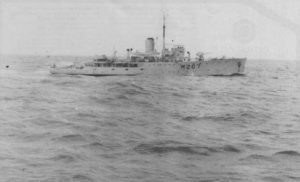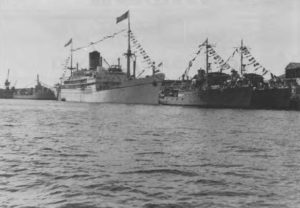- Author
- Hall, Roy
- Subjects
- History - post WWII
- Tags
-
- RAN Ships
- HMAS Stirling (Shore establishment), HMAS Fremantle I, HMAS Junee, HMAS Mildura
- Publication
- September 1990 edition of the Naval Historical Review (all rights reserved)
Upon cessation of hostilities in 1945, many ships of the world navies were laid up as their ‘hostilities only’ officers and ratings rejoined the civilian workforce. Many ships of the RAN were decommissioned at various ports around Australia, with quite a few of the ‘Bathurst’ Class Australian minesweepers being laid up at Careening Bay off Rockingham, Western Australia. During the next ten years some of these Australian Corvettes, as they were popularly known, were recommissioned for training duties.

The main function of these ships was to give sea training to National Servicemen and to Officers and men of the then newly formed RAN Reserve. The ships were manned with sufficient permanent personnel in all departments to maintain the ships and to provide the necessary instruction and supervision as required, of the National Servicemen and the Reserves.
Ships that come to my mind were Junee, Mildura and Fremantle and I was fortunate to undertake periods of 13 days Annual Continuous Training (ACT) in all three of these ships from time to time.
All had been recommissioned from Reserve after extensive wartime service with Fremantle being one of the corvettes laid up at Careening Bay, Garden Island. Today this area is the site of the Naval base of HMAS Stirling. Fremantle was refitted for her role in Fremantle on the old slipway behind ‘A’ Shed at Victoria Quay.

One of the most memorable ACTs which I did was in Mildura in early May, 1952. The Commanding Officer was Lt. Cmdr. Malcolm Brommell who had joined the RANVR as I had in 1941 under the Admiralty ‘Yachtsman’ scheme. The Reserve contingent joined the ship early on the Sunday morning and in the afternoon we sailed into the teeth of a south westerly gale, the usual Fremantle weather. Before we had even cleared the North Mole the ship was bucking like a bronco, and mercifully we anchored in Cockburn Sound for the night to enable everyone to shake down and to stow gear properly.
Early the next day we sailed Northbound with very lively movement on the ship and ‘mal de mer’ at the wheel until Geraldton was abeam. On this occasion Mildura was to be employed in some preliminary survey work around the Monte Bello Islands and on the approaches to the Fortesque River estuary between Onslow and Dampier prior to the series of British atomic tests in the islands.

In the heavy going the ‘Brown’ Gyro was soon ‘on the blink’ and we had to resort to the magnetic compass. All good training they said, and it was, for those of us who had always taken the gyro for granted. There followed too, much discussion about the infamous North Westerly set on to the coast, the preponderance of pecked lines on the chart and the numerous warnings which had been on the chart since HMS Beagle had been this way 110 years before. Our Type 271 Radar was deemed to be ‘unreliable’, and it was! In the wee hours one morning in thick weather, Cape Inscription light appeared on the port bow instead of comfortably to starboard. Later we anchored in Shark Bay in the lee of Dorre Island and during the Dogs we sent away the whaler. It returned in due course nearly ‘gunnels’ under with a load of schnapper, many of the fish weighed in at 15 lbs. Fresh fish and chips was on the menu that night for all hands. There was still sufficient fish left over for those of us returning home to take a frozen specimen wrapped in hessian to show something for our labours whilst on Reserve training.




